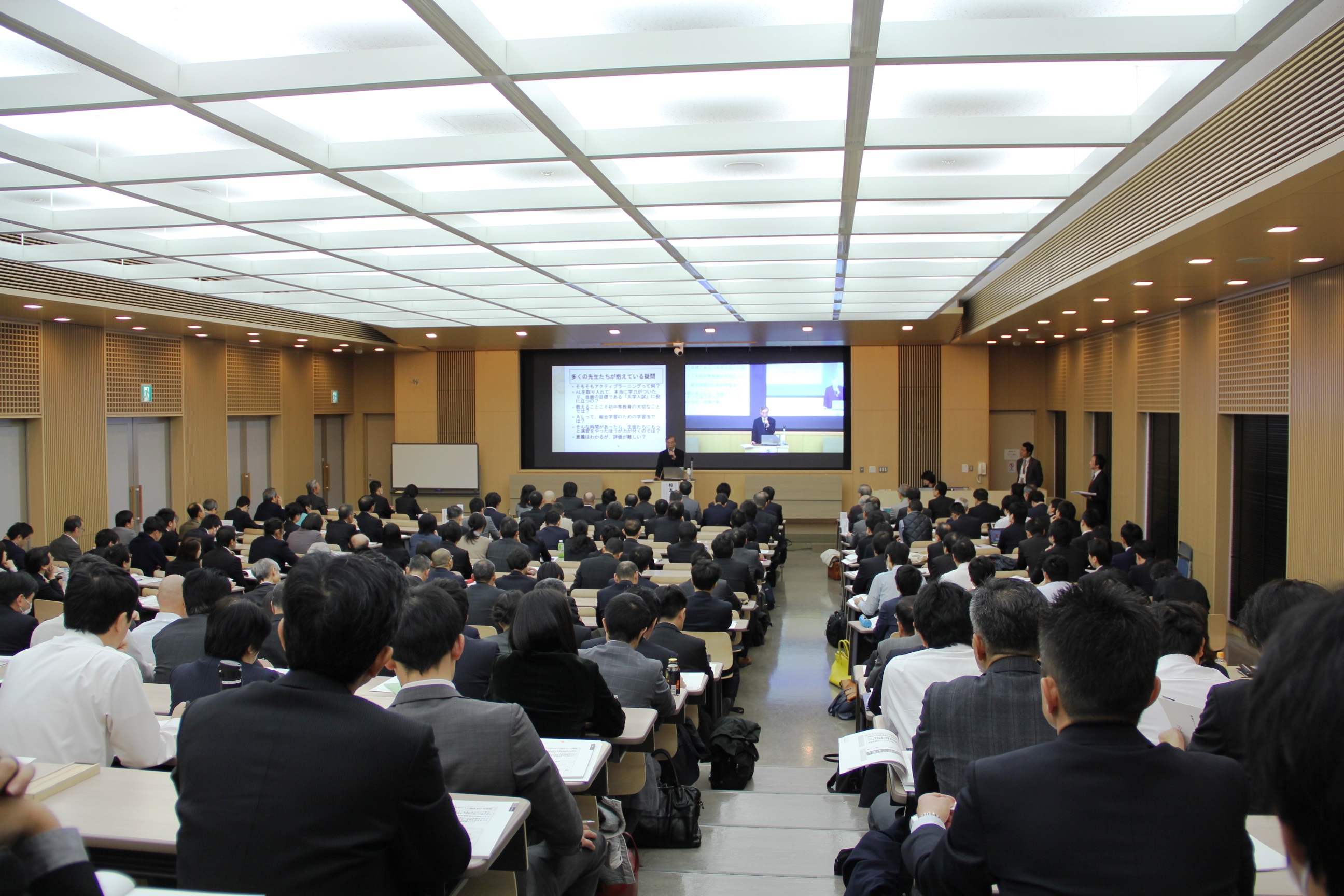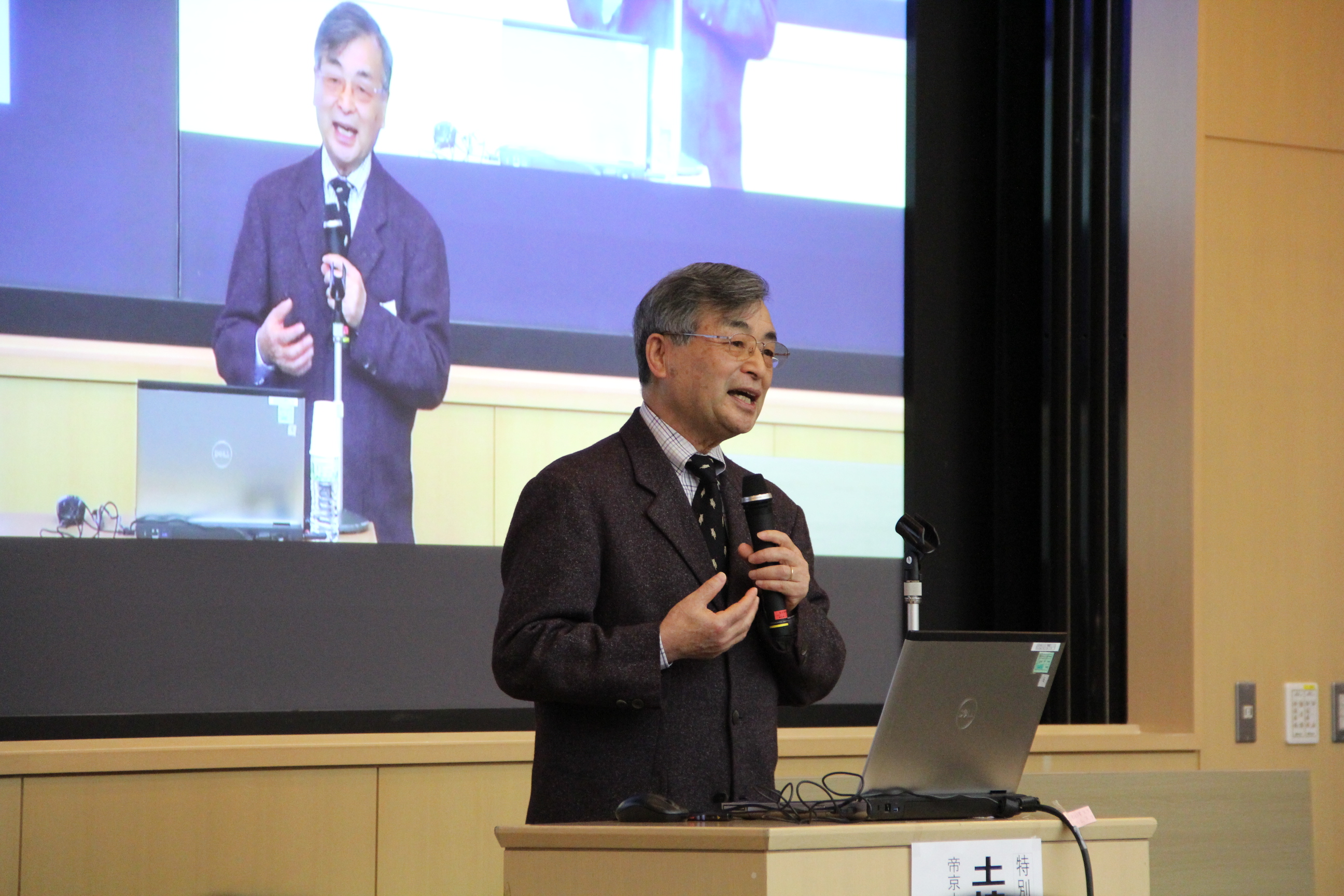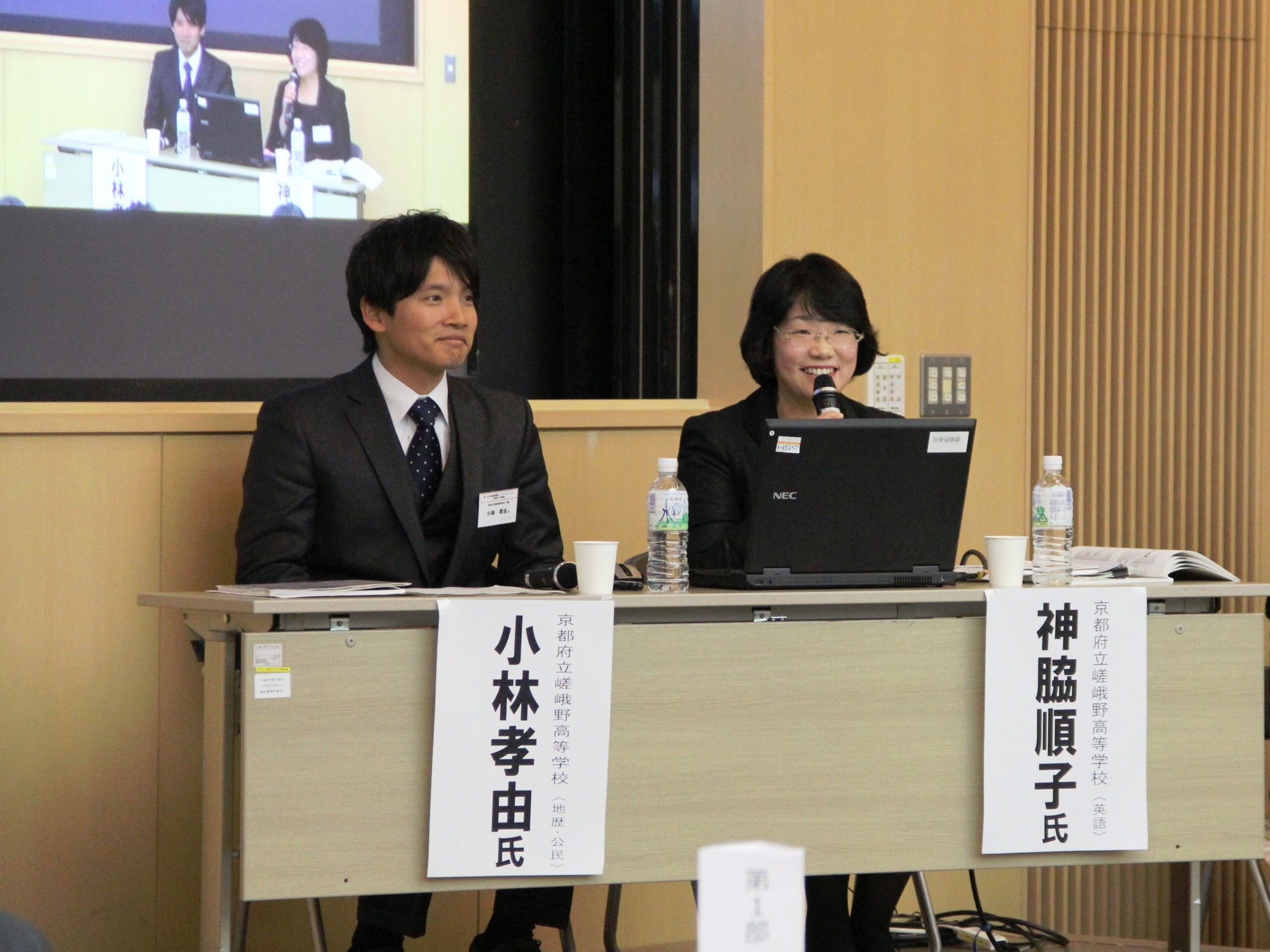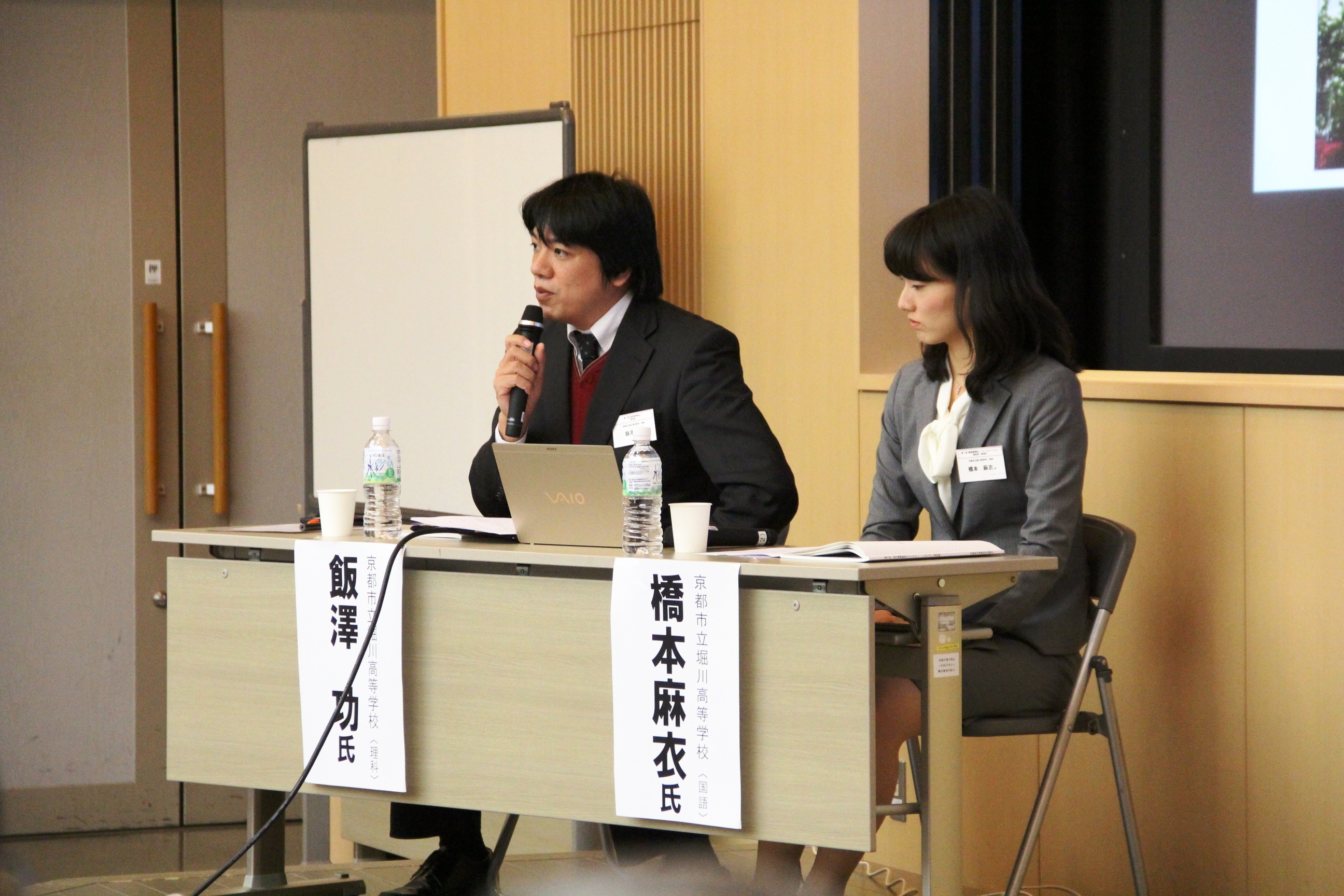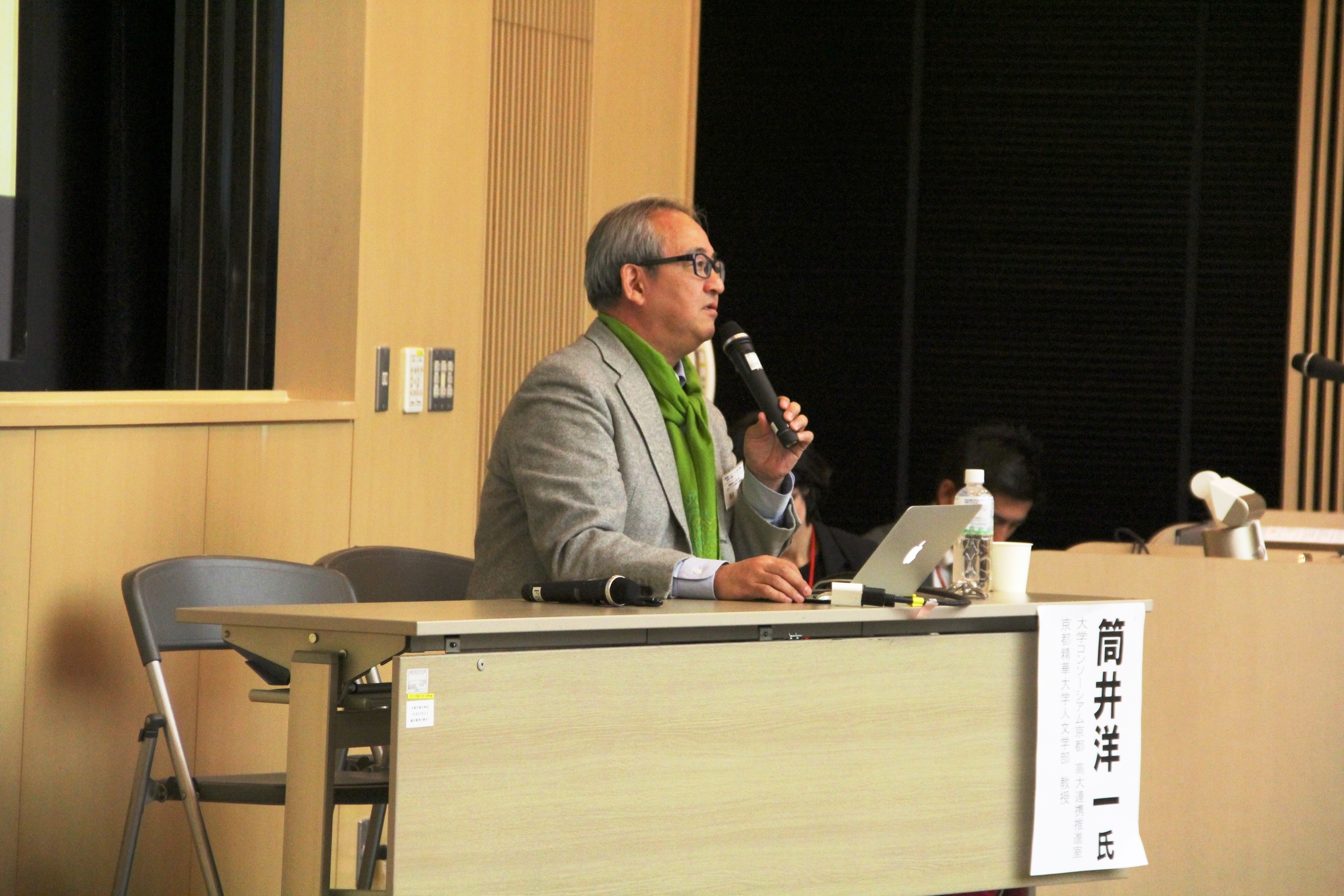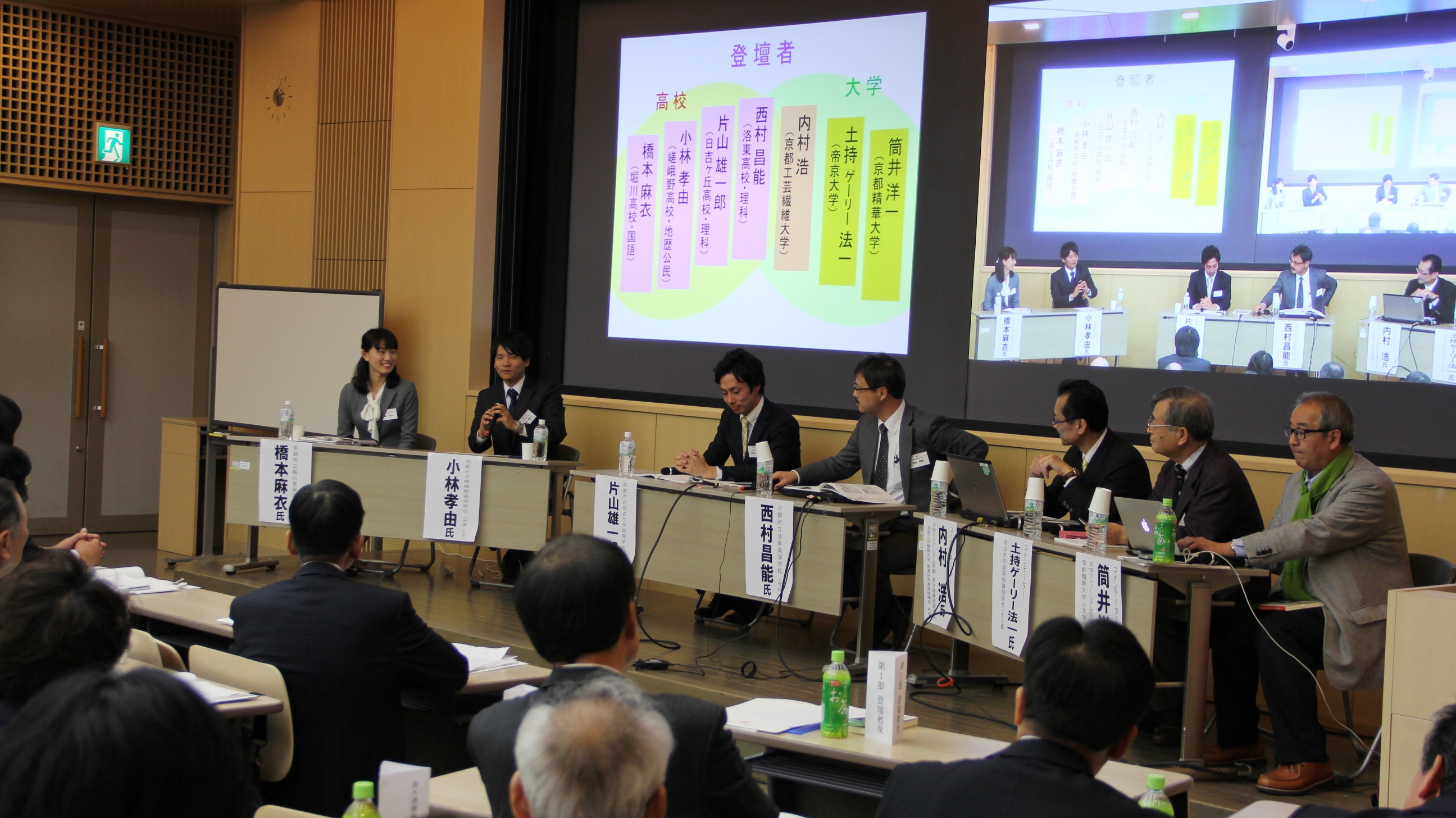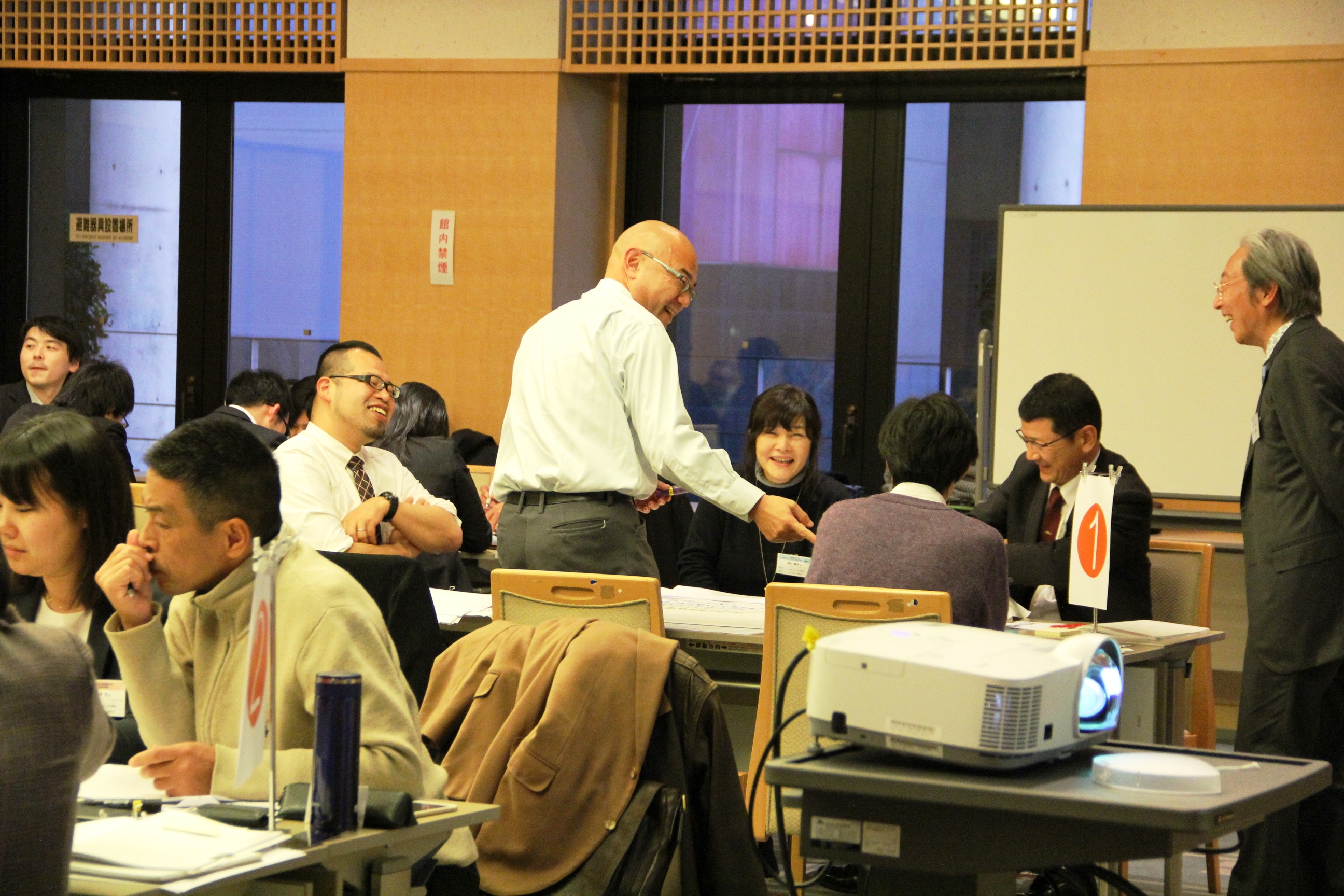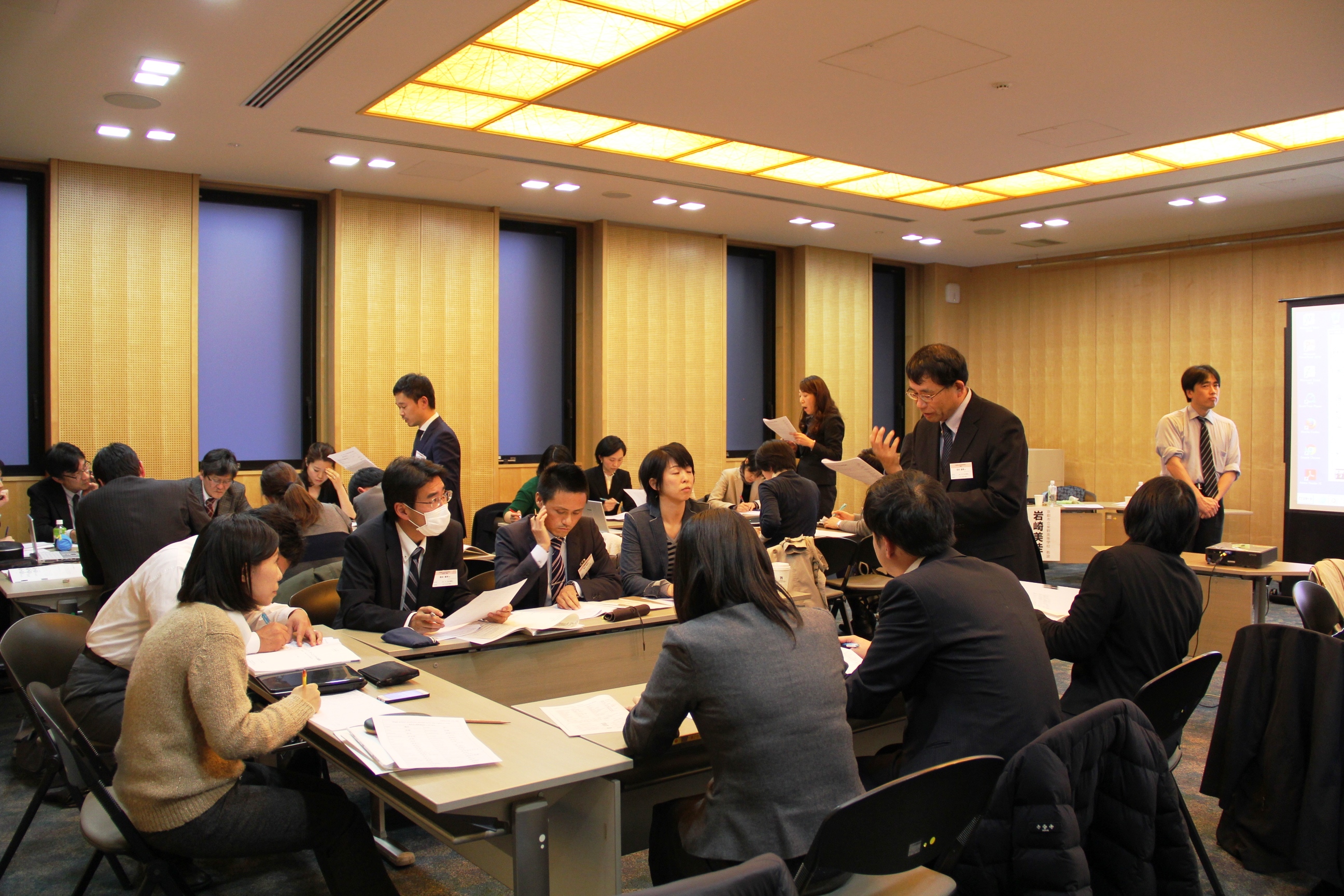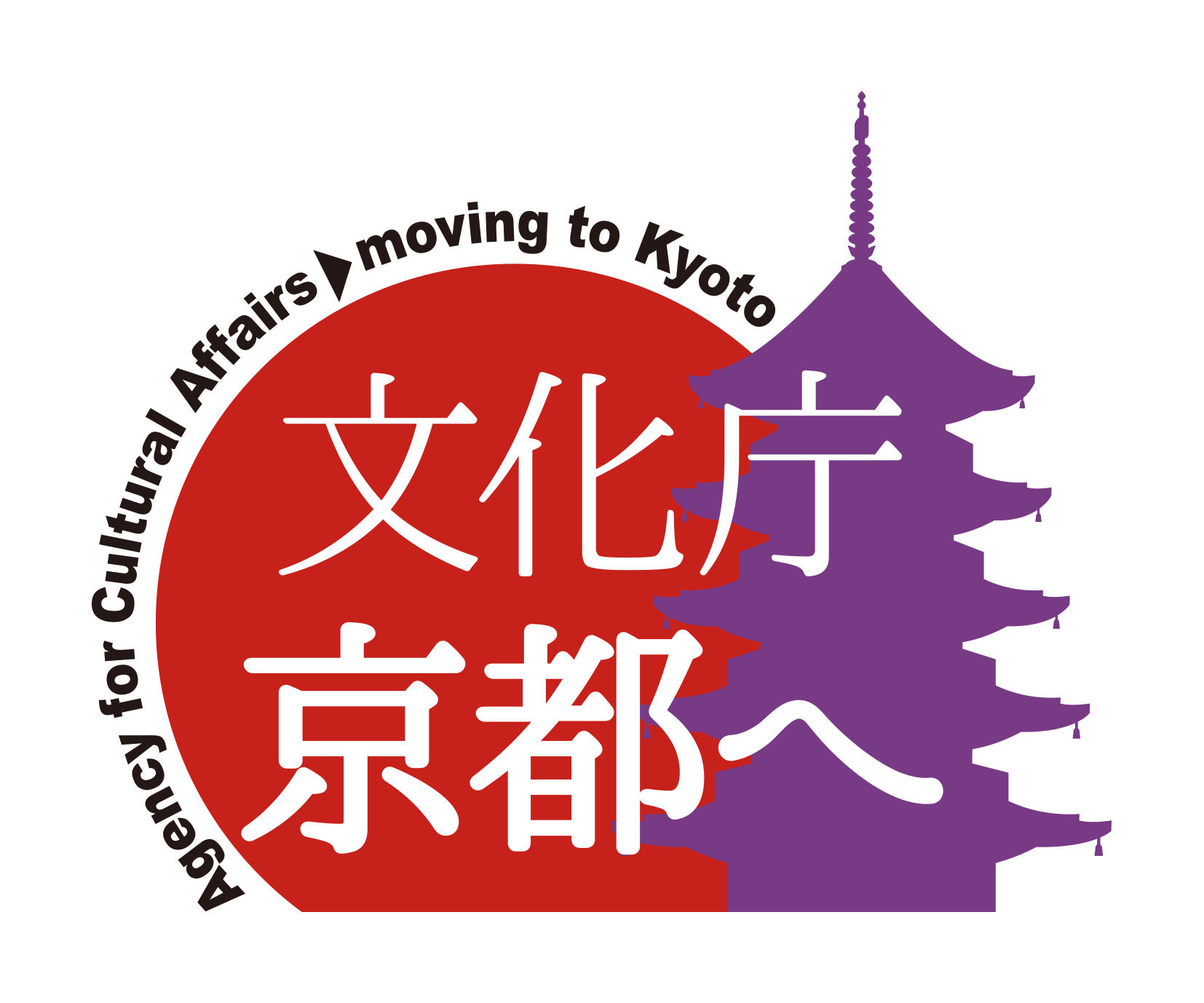Business Overview
The forum is held for the purpose of “sharing information on domestic trends and disseminating information on initiatives in Kyoto” in the issue of collaboration and connection education between high schools and universities.
Outline of the event
The 13th Forum on Collaborative Education between High School and University
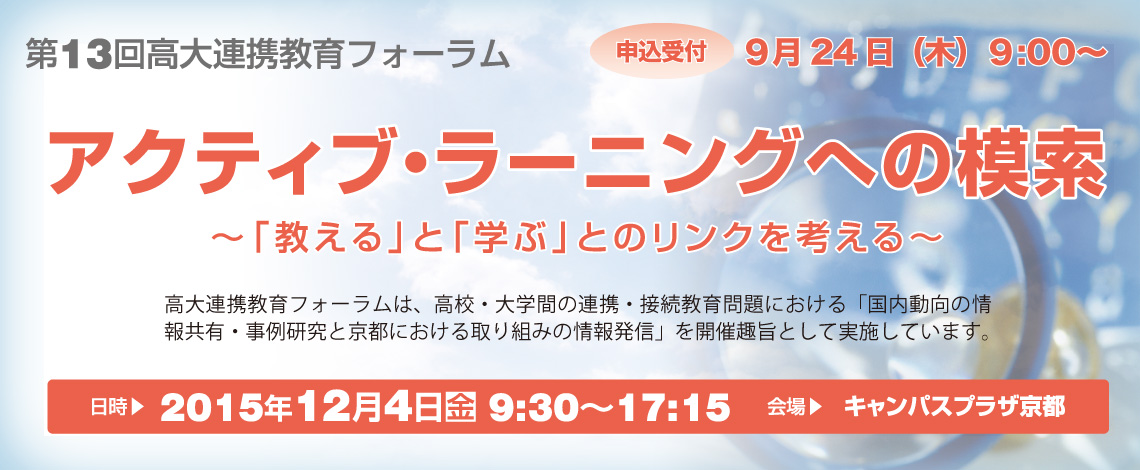
| Date: | , December 4, 2015 9:30~17:15 | |
| Venue: | Campus Plaza Kyoto | |
| Theme: | Exploring Active Learning ~Thinking about the link between “teaching” and “learning”~ | |
| Organizer: | Kyoto High School-University Collaborative Research Council (Kyoto Prefectural Board of Education, Kyoto City Board of Education, Kyoto Prefectural Federation of Private Junior and Senior High Schools, Kyoto Chamber of Commerce and Industry, University Consortium Kyoto) | |
| Explanation | of the purpose of the meeting, special lectures, introduction of practical examples, discussion | 200 people (first-come, first-served basis) |
| Breakout Groups 1, 2, 3, 4 | 30 people each) (first-come, first-served basis) | |
| Registration: | Thursday, September 24, 2015 9:00 a.m. ~ Saturday, October 31, 2015 5:00 p.m. | |
| Participation fee: | 1,000 yen | high schools and universities in Kyoto |
| Persons other than the above (including participants from companies in Kyoto Prefecture) | 2,000 yen | |
The 13th High School-University Collaboration Forum Leaflet![]()
(Part 1) 9:30~14:45 Keynote Report, Special Lecture, Case Study
Moderator: Ms. Iwako Yamamoto (Associate Professor, Institute of Education and Research, Kyoto Institute of Technology / Coordinator, Kyoto High School University Collaboration Promotion Office, University Consortium)
| Opening Remarks 9:30~9:35 |
Mr. Satoshi Kitamura (Principal of Kyoto Gaidaishi High School / Chairperson of the Kyoto High School Collaborative Research Council Steering Committee) | |
| Explanation of the purpose 9:35~9:45 |
Hiroshi Kakumoto (Lecturer, Faculty of Industrial Sociology, Ritsumeikan University / Advisor, Kyoto High School-University Collaboration Promotion Office, University Consortium) | |
| Special Lecture 9:45~10:35 |
Theme: Shifting from “Teaching” to “Learning”: Practice and Evaluation of Active Learning Using the ICE Model in High School-University Connection Education Speaker: Dr. Gary Hoichi Domochi (Director, Center for Higher Education Development, Teikyo University) |
|
| Currently, various forms of active learning (AL) are being introduced in high schools and universities, but it is important to foster the ability of students and students to think independently, and for this purpose, it is necessary to shift from conventional “learning” to “learning,” that is, teaching methods and perspectives that focus on what students have learned rather than what teachers have taught. In addition, the biggest challenge in AL is evaluation, and although rubric evaluation is currently attracting attention in Japan, many people may have felt that the evaluation criteria are ambiguous. What is the evaluation that enhances the quality of student learning? Focusing on the ICE (Basic Knowledge, Learning Connection, and Knowledge Application) model, which is a new learning and evaluation method that is attracting attention in Canada, I would like to think about how to practice AL and how to measure its effectiveness. | ||
| Practical examples (High School) 10:45~11:45 |
Theme: The Challenges of Introducing Active Learning That No One Teaches ~Exploring in the Dark of Sagano and Horikawa~ Presenter: Kyoto Prefectural Sagano High School, Junko Kanwaki (English) / Takayoshi Kobayashi, Teacher (History, Civics) Kyoto Municipal Horikawa High School Isao Iizawa Teacher (Science) / Mai Hashimoto Lecturer (Japanese) |
|
| In promoting the introduction of active learning (hereinafter referred to as “AL”) in schools, there are many issues such as teacher training, awareness sharing among teachers, and raising students’ awareness of AL-type learning. Until now, Sagano High School and Horikawa High School have been promoting the development and implementation of curricula, systems, and class content to express the desire to learn in students. In this report, teachers who have been involved in the development and implementation of these technologies at both schools, as well as young teachers who are trying to develop classes that encourage active learning for students under the curriculum of both schools, will report and discuss the issues that need to be solved in order to introduce AL. |
||
| Practical examples (University) 11:45~12:15 |
Theme: The Role of Teachers as Learning Companions for Students Presenter: Yoichi Tsutsui (Professor, Faculty of Humanities, Kyoto Seika University / Coordinator, Kyoto High School University Collaboration Promotion Office, University Consortium) |
|
| Active learning (AL) is often perceived as being implemented by some schools and universities that can implement active learning (e.g., whether or not they go on to higher education) depending on the ability of the student or student. However, AL is not a question of students and students, but rather how teachers can change their teaching mindset. As one of the attempts to transform students into “companions in learning,” we will consider the case of creating a class together with off-campus volunteers. | ||
| 【Break】12:15~13:15 | ||
| discussion 13:15~14:45 |
Speaker: Kyoto Prefectural Rakuto High School, Masano Nishikawa, Teacher (Science) Kyoto Municipal Hiyoshigaoka High School Yuichiro Katayama, Teacher (Science) Kyoto Prefectural Sagano High School Takayoshi Kobayashi Teacher (History, Civics) Kyoto Municipal Horikawa High School Mai Hashimoto Lecturer (Japanese) Commentators: Mr. Hoichi Domochi, Mr. Yoichi Tsutsui Coordinator: Hiroshi Uchimura (Professor, Institute of Education and Research, Kyoto Institute of Technology / Director, Kyoto High School University Collaboration Promotion Office, University Consortium) |
|
| With other high schools engaged in active learning, we will share the practical status of high schools and future issues, and deepen discussions on the direction we should aim for. | ||
(Part 2) 15:15~17:15 Breakout Sessions
| Session 1 [Expression technique] |
Theme: Evaluation Methods for Active Learning: A Self-Evaluation System for Learners Speaker 1: Seiichi Ohki (Former Teacher, Kobe International University High School) Presenter 2 and Coordinator: Yoichi Tsutsui (Professor, Faculty of Humanities, Kyoto Seika University / Coordinator, Kyoto High School-University Collaboration Promotion Office, University Consortium) |
|
| Active learning, a class practice that encourages students’ independence, is required at universities, and it is increasingly being used as a keyword for collaboration between high school and university. On the other hand, it is not always possible for students to achieve “deep learning” if they are only actively engaged. Among them, it is emphasized that it is necessary to incorporate “evaluation for learning” or “evaluation as learning” for students themselves as an evaluation method in active learning. PISA2015 problem-solving framework seeks to assess an individual’s problem-solving skills in collaborative situations. In this workshop, after a brief explanation, participants will experience an evaluation using PISA2015 and think about the relevance of the workshop to their own classes while doing their own work. Here, as an opportunity for students to reflect on how deeply and strategically they are engaged in activities within the group work (formative assessment), we aim to practice and exchange ideas with participants on how to use PISA2015 problem-solving framework. |
||
| Session 2 [Mathematics] |
Theme: Promotion of Active Learning -Kyoto Mathematics Grand Prix- Presenter 1 and Coordinator: Hiroshi Mizuguchi (Supervisor, High School Education Division, Kyoto Prefectural Agency of Education) Presenter 2: Naoko Kishimoto (Teacher, Kyoto Prefectural Nanyo High School) Speaker 3: Masayuki Asaoka (Associate Professor, Graduate School of Science, Kyoto University) |
|
| The Kyoto Prefectural Board of Education has developed the Kyoto Mathematics Contest, which began in the 19th academic year, with the aim of fostering human resources in the field of science and mathematics and making more students feel the fun and interest of mathematics, and has been holding the “Kyoto Mathematics Grand Prix” in collaboration with Kyoto University since the 21st academic year. This time, we will report on the efforts of the 2nd stage, the Kyoto Mathematics Olympiad Dojo. The Japan Mathematics Olympiad Qualifying Tournament is held every January, and this initiative is positioned as a study session for that purpose. Junior high and high school students who are interested in the Math Olympiad gather at Kyoto University to exchange and discuss solutions based on past questions. Staff members (university teachers, high school teachers, and graduate students) work together to select the subjects to be dealt with, taking into account the qualities and abilities they want to acquire. In addition, in order to enrich the independent and collaborative learning of the participating students, the staff is working on initiatives while exchanging ideas. In this subcommittee, we would like to not only introduce this initiative, but also exchange opinions with the participants to promote independent and collaborative learning. |
||
| Subcommittee 3 [English] |
Theme: English Communication and Thinking Skills Cultivated through Debate Activities Presenter 1: Mika Iwasaki (Teacher, Kyoto City Murasaki High School) Speaker 2: Tomohiro Nakagawa (Assistant Professor, Graduate School of Engineering, Osaka Prefecture University) Coordinator: Yoko Taiyama (Supervisor, School Guidance Division, Guidance Department, Kyoto City Board of Education) |
|
| At Kyoto Municipal Murasakino High School, one of the educational goals is to “nurture future international citizens,” and has been focusing on the development of practical English skills and practicing English debate in the classroom. In this article, we will report on how debate activities are useful for communication and logical thinking in English, while introducing the activities of the students. Even in universities, especially in the field of science, it is common to give presentations and discussions in English in a global setting. In this issue, a team led by Assistant Professor Nakagawa of the Department of Mechanical Engineering, Graduate School of Engineering, Osaka Prefecture University, will report on the rules of impromptu English debate, its usefulness, and efforts to popularize debate, including impromptu English debate instruction at Kyoto Municipal Murasaki High School. I would like to discuss how to teach and evaluate English debate activities as active learning and how to use them in the classroom, including debate workshops. |
||
| Session 4 [Science] |
Theme: Practical training for high school students using synchrotron radiation to nurture future scientists ~Presentation activities that emphasize students’ autonomy in collaboration with high school and university~ Speaker 1: Hisashi Kuriki (Teacher, Ritsumeikan High School) Speaker 2: Toshiaki Ota (Director, Professor, Research Organization of Science and Technology, Ritsumeikan University) Coordinator: Hiroshi Tanaka (General Manager, Ritsumeikan Integrated Education Department) |
|
| Ritsumeikan University, its affiliated schools, and partner schools are taking advantage of the strengths of the same school to carry out many meaningful high school-university collaboration projects. One of the most symbolic initiatives is the annual training of high school students at the SR Center, a research facility that uses synchrotron radiation at the Biwako-Kusatsu Campus. In this two-day practicum, students boldly tackle themes that transcend the high school level through the following steps: explanation (introduction) of SR, practical training (experience), sharing of knowledge (discussion), and presentation (expression) using PowerPoint. In addition, the participating students will be more aware of science, and it will play a role in greatly increasing their interest, concern, and motivation for future scientific research. At the same time, it is changing the attitude towards learning in high school. We would like to convey how high school students grow by adding initiatives that take advantage of the autonomy of high school students (active learning) with the cooperation of universities based on state-of-the-art research facilities. | ||
Implementation Report
The 13th Forum on Collaborative High School-University Education Report [Click here for details]
This year’s seminar was held under the theme of “Active Learning (AL),” which has been decided to be introduced into the next course of study and is of increasing interest among high school teachers, and three-quarters of the participants were high school officials, and the total number of participants was about 300, which was much higher than in previous years.
In the first part of the lecture, “Special Lecture,” Prof. Domochi of the Center for Higher Education Development, Teikyo University, suggested that it is effective to acquire sufficient basic knowledge in advance and then incorporate AL in a short period of time, rather than formally introducing AL, and that subsequent reflection is particularly important. In addition, regarding the evaluation of AL, which is cited as an issue by many people, quantitative evaluation is difficult and qualitative evaluation is required, and we learned that the learning portfolio is an effective method. In addition, the ICE model and the use of ICE verbs introduced will be of great use in high school education in the future.
In the “Practical Case Study (High School)” section, Sagano Prefectural High School and Horikawa Municipal High School, which are advanced AL schools in Kyoto, jointly gave presentations. On the day of the event, they did not just present their results, but also took turns presenting on the same theme, interweaving questions to each other in between, and devised a way to make presentations, focusing on the trial and error so far, what they discovered in the process, and the barriers they overcame.
In “Practical Examples (University),” Prof. Tsutsui of Kyoto Seika University introduced the importance of changing the conventional view of learning, as well as the significance and effectiveness of classes created not only with faculty members but also with students and working adults.
In the afternoon, in order to further delve into AL in high school settings, we invited speakers from Rakuto Prefectural High School and Hiyoshigaoka Municipal High School to hold discussions. When he introduced specific examples of high school settings in various academic levels, many participants nodded their heads and listened.
In the second part, as in previous years, the participants were divided into subcommittees on “Expression Techniques,” “Mathematics,” “English,” and “Science,” and shared practical examples of AL by subject and theme, and actively exchanged opinions.
In the next fiscal year, we plan to hold the event with a theme that is in line with the trends of the times, while keeping a close eye on the educational trends of the country, so we hope that you will join us.
Inquiries
University Consortium Kyoto High School-University Collaborative Education Forum
TEL 075-353-9153 FAX 075-353-9101
〒600-8216 Shimogyo-ku, Kyoto-shi, Nishitoin-dori, Shiokoji, Shimo-ku, Kyoto, Campus Plaza Kyoto
* Reception hours: Tuesday ~ Saturday 9:00 ~ 17:00 (excluding year-end and New Year holidays)














